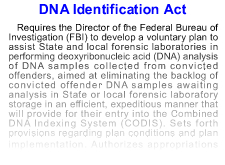Archival Notice
This is an archive page that is no longer being updated. It may contain outdated information and links may no longer function as originally intended.
Home | Glossary | Resources | Help | Contact Us | Course Map
In 1994, the U.S. Congress passed the DNA Identification Act (Public Law No. 103-322 -1994).01 This law, in part, mandated that the FBI was responsible for the Combined DNA Index System (CODIS).
In 1996, the Department of Justice, through the FBI and the Technical Working Group on DNA Analysis Methods (TWGDAM), funded the CODIS STR Standardization Project.
The purpose of this project was to evaluate various STR loci and to establish core loci for the CODIS. Crime laboratories from Alabama, Arizona, California, Florida, Michigan, New York, North Carolina, Oregon, Texas, and Virginia, together with the Armed Forces DNA Identification Laboratory (AFDIL), the FBI, the National Institute of Standards and Technology (NIST), and the Royal Mounted Canadian Police (RCMP) participated in the study. Two manufacturers, Applied Biosystems and Promega, also participated in the STR Standardization Project.
Prior to this project, each manufacturer had forensic multiplex STR kits available:
- Applied Biosystems AmpFℓSTR® Profiler™
- Amelogenin
- CSF1PO
- D3S1358
- D5S818
- D7S820
- D13S317
- FGA
- TH01
- TPOX
- vWA
- Applied Biosystems AmpFℓSTR® Green II™
- Amelogenin
- D8S1179
- D18S51
- D21S11
- Promega PowerPlex®
- CSF1PO
- D5S818
- D7S820
- D13S317
- D16S539
- TH01
- TPOX
- vWA
Additional Online Courses
- What Every First Responding Officer Should Know About DNA Evidence
- Collecting DNA Evidence at Property Crime Scenes
- DNA – A Prosecutor’s Practice Notebook
- Crime Scene and DNA Basics
- Laboratory Safety Programs
- DNA Amplification
- Population Genetics and Statistics
- Non-STR DNA Markers: SNPs, Y-STRs, LCN and mtDNA
- Firearms Examiner Training
- Forensic DNA Education for Law Enforcement Decisionmakers
- What Every Investigator and Evidence Technician Should Know About DNA Evidence
- Principles of Forensic DNA for Officers of the Court
- Law 101: Legal Guide for the Forensic Expert
- Laboratory Orientation and Testing of Body Fluids and Tissues
- DNA Extraction and Quantitation
- STR Data Analysis and Interpretation
- Communication Skills, Report Writing, and Courtroom Testimony
- Español for Law Enforcement
- Amplified DNA Product Separation for Forensic Analysts


